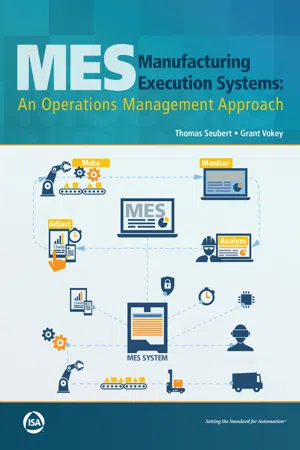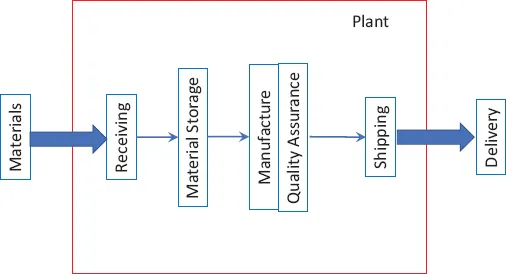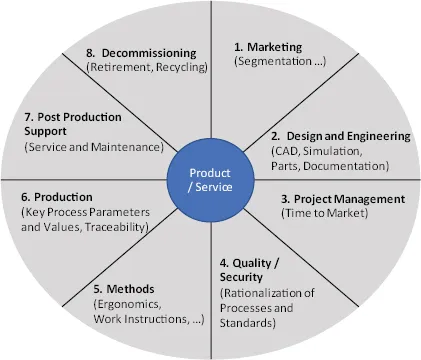![]()
1
Introduction, Overview, and the Current State of Manufacturing
1.1 Introduction
Before we can discuss manufacturing execution systems (MES), we must examine the manufacturing enterprise and operation as a whole to understand how these systems fit into the big picture.
Let us start with the scope of manufacturing. Simply put, it is the entire process from procuring, receiving, and storing materials in the plant (or a nearby warehouse) to the fabrication (or assembly) and quality assurance of the manufactured part, and possibly the shipment of the product to the first-level customer.
Manufacturing, which includes all activity within the plant, is illustrated in Figure 1-1.
It takes considerable coordination to properly manufacture a product. The following is a list of the high-level processes within the scope of manufacturing:
Figure 1-1. Manufacturing scope.
• Material procurement – When, how much, and from whom
• Material receipt (including incoming inspection) and storage – Frequency of delivery, where to place the delivery once it is in-house, and verification of material quality
• Material and product inventory management – All material movement within the plant
• Production planning and scheduling – When to produce and how much, which includes sequencing the manufacturing processes for the product or subassembly at both the subassembly line level and the final assembly level
• Maintenance and readiness of tooling and conveyance systems – Ongoing maintenance and calibration keeps the tooling and conveyance available when needed
• Training and readiness of operators, supervisors, and other staff – Having both the knowledge to perform the work and the right skills available when they are needed while minimizing cost
• Product quality assurance – When tests should be performed on products or materials to check the product’s quality while reducing potential waste if something goes wrong
• Shipping scheduling and coordination – Ensuring the product is shipped with enough time to deliver on time and minimizing shipping costs
These processes require the careful coordination of material, resources, and information to make and deliver the product efficiently. As such, operations must recognize that any work performed toward the fabrication or assembly of a production unit is an investment that is not recovered until the product is sold, and operations costs for producing finished goods (including scrap, direct labor, and material) must be recovered in the sales price of the product. As with any investment, operations must try to reduce the investment needed to make each sellable product.
Beyond the full scope of manufacturing, the scope of an MES is generally from the point of goods issue to the production floor (material moved from inventory to local holding on the production floor), through the process of fabrication and/or assembly, to the point of goods receipt from the production floor (movement of completed products back into inventory ready for the next stage of production or sales).
All this processing is based on the current status and ongoing updates to the product design as well as updates to valid materials used during the product’s life cycle. Additionally, demand must account for variations in the product to be delivered to the end customer as the consumer goods industry moves toward mass customization, which will potentially increase manufacturing costs. Making and delivering a product at the lowest possible price is ultimately what manufacturing operations management (MOM) is all about. To understand how an MES affects the efficiency of producing a product, we must understand how it fits into the MOM model (see Figure 1-2).
MOM refers to the processes and procedures that plan, deliver, and support the manufacturing of products with most of that activity creating interaction between enterprise resource planning (ERP), product life-cycle management (PLM), and MES.
Figure 1-2. Simplified MOM diagram.
1.2 ERP Business Process
ERP is the set of processes that includes business and capacity planning, scheduling, and customer order management. Accounting and Human Resources are part of these processes because they represent the management of all the resources (people, material, etc.) required to execute manufacturing. Figure 1-3 shows the business processes that are part of the ERP environment.
A full review of the function of ERP is beyond the scope of this book.1 For the purposes of this overview, the following functions are important for manufacturing:
• Capacity management – What is the maximum capacity of a manufacturing plant? This is highly dependent on the number and mix of end products and how they are manufactured. For every product to be manufactured, there is a defined process. There is also a maximum number of units that can be manufactured in a given time. This will affect both the production order planning and the material procurement planning.
• Production planning – As with everything else, manufacturing must be planned, sometimes down to the smallest element of the process (remember the efficiency of reducing the investment of time and material). In addition, as a part of production planning, there is a need for the planning staff to understand the current status of the production environment. Adjusting the production plan according to changes in this status is a major part of the production planning process. Planning must also account for changes in the current status of the production environment as changes happen.
Figure 1-3. ERP modules.
• Customer relationship management (CRM) – This function includes processes that ensure the customer is happy and satisfied with the end product. In addition, CRM anticipates the customer’s future demand and then recommends changes to the product line accordingly with any details that would affect the manufacturing process.
• Supply chain management (SCM) – These processes ensure all materials, including raw materials and component parts, are delivered to the plant on time and adhere to the expected level of quality.
1.3 Product Life-Cycle Management Business Process
Product life-cycle management (PLM) is the support for the business process that manages the design, engineering, manufacturing planning, services, and eventual decommissioning of a product (or product line). Figure 1-4 shows the business processes that are part of the PLM environment.
Figure 1-4. PLM model.
For the purposes of this overview, the processes that are important within the manufacturing company include the following:
• New product introduction – The process of taking a product from concept to marketable product, which includes planning and managing necessary changes in the manufacturing environment to launch the new product. Also included, but not part of manufacturing, are the marketing and other plans to induct the new product into the market. Because a considerable investment must be made to launch a new product, it is critical to control and manage this part of the process.
• Product design – This will impact how the product will be manufactured. It incorporates concepts covered in a design methodology called design for manufacturing (DFM). Once again, discussion on the full scope of DFM is beyond this book. However, in many cases, physical limitations in the product design will have a major impact on how the product will be manufactured. This can include chemistry in material interactions, limitations in manipulating materials, and other constraints.
• Product upgrades – This includes changes to the product during its life cycle. Many changes can significantly affect the manufacturing environment, from different vendors and therefore different SCM processes to different manufacturing and quality assurance processes. Understanding when a new design should be introduced or a design should be upgraded during the product’s life cycle is an important part of reducing waste caused by material obsolescence.
• Manufacturing work instructions – This refers to the alignment of manufacturing work instructions to design intents for assembly. As previously noted, how a product is put together has a direct relationship with the design of the product and how it will perform after manufacturing. This takes careful coordination between Manufacturing Engineering and Product Engineering.
• Product decommissioning – The process of ramping down the product as it approaches the end of its sales life. At times, this affects how the product is manufactured as product volume decreases and required materials are depleted.
Additional information on PLM can be found on Wikipedia.2
1.4 MES Business Processes
MES includes both the business and the manufacturing processes used to produce a product as well as the technology necessary to ensure that the product is properly manufactured. MES are also used to ensure the manufacturing equipment is in good working order to protect product quality. The implementation of an MES should provide maximum visibility and should control the entire manufacturing environment. In other words, if something happens on the production floor, the MES should be aware of it, record it, and have the capability to control it, all in real time.
An MES operates at a task level in production, and each task in the assembly process...




